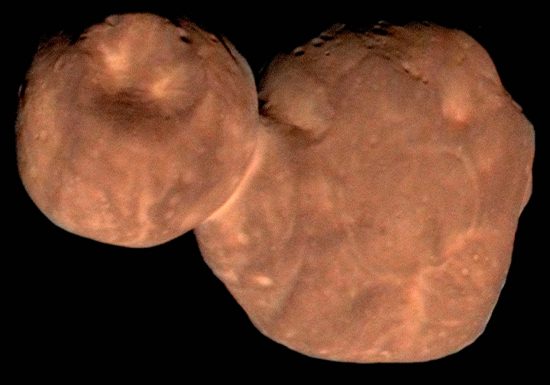
May 17, 2019
New Horizons continues its voyage into deep space.
Many Pictures of the Day discuss the way that conventional science views the world, and how Electric Universe theory provides a paradigm that allows consistent applications of its concepts to various phenomena. Comets, in particular, are so completely different in the two viewpoints that it is as if they are different things, entirely.
NASA launched the New Horizons spacecraft on January 19, 2006. Picture of the Day articles followed the spacecraft throughout its primary mission as it confirmed many Electric Universe principles when it flew by the Pluto/Charon system on July 14, 2015. On January 1, 2019 New Horizons flew by a remote object near the edge of the Kuiper Belt recently named, “Ultima Thule”.
At flyby time, Ultima Thule was about 6.5 billion kilometers from the Sun, making it the most distant flyby of a celestial object, and the first time that anything like it was seen close-up. Ultima Thule is approximately 30 kilometers in diameter, with an irregular shape. Ultima Thule is described as a “contact binary”, and is similar in shape to Comet 67P/Churyumov-Gerasimenko.
According to a recent press release, scientists do not know how the “two lobes” of Ultima Thule combined into one body. They persist in thinking of the Kuiper Belt Object (comet) as a conglomerate, so the only recourse is to find ways that separate bodies can combine in space, when the allowable forces are gravity and inertia.
However, Ultima Thule reveals characteristics that demand it be reconsidered. Instead of one or more compacted objects, it should be thought of as one object that was drastically altered by electricity at some time in the past. The marks of electric arcs are visible in several areas: two crater chains, and the presence of smaller craters on the rim of the big one indicate electric discharges to its surface. Just like the aforementioned 67P/Churyumov-Gerasimenko, its “neck” is a mark of electrical erosion, and not where two bodies joined together.
Ultima Thule is reddish in color. This is most likely due to large organic molecules called tholins that were discussed in previous Picture of the Day articles. Tholins cannot exist naturally on Earth, because atmospheric oxygen quickly destroys them. They can be synthesized in laboratory isolation, however, by sending electric arcs through various combinations of methane and ammonia. Another possible explanation is that it is made up from planetary debris, so its color looks like compounds found elsewhere in the Solar System.
New Horizons is now 6.6 billion kilometers away, and carries a velocity of 53,000 kilometers per hour, relative to Earth. Mission specialists are continuing to download its data, with completion scheduled for some time in the Summer of 2020. As time goes on, more Electric Universe theories are expected to be confirmed.
Stephen Smith












